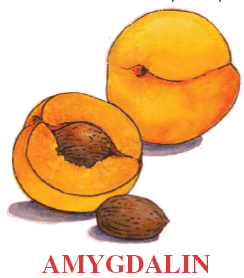Amygdalin (Vitamin B17)
A substantial number of cancer patients turn to unconventional agents used as anticancer therapies. However, “alternative cures” are unproved and may be harmful. They are not supported by clinical research and they can jeopardize patients’ lives, especially when patients delay needed care. Amygdalin, promoted as a popular alternative cancer cure for over 40 years, is used by many cancer patients. No solid data supports its effectiveness.
A substantial number of cancer patients turn to unconventional agents used as anticancer therapies. However, “alternative cures” are unproved and may be harmful. They are not supported by clinical research and they can jeopardize patients’ lives, especially when patients delay needed care. Amygdalin, promoted as a popular alternative cancer cure for over 40 years, is used by many cancer patients. No solid data supports its effectiveness. In addition, cyanide toxicity and contaminated products have been reported.
Despite these concerns, many websites promote amygdalin as a viable cancer treatment. Patients should be aware of misleading marketing and know that “alternative” cures are not viable options. Amygdalin is banned in the United States, but is available in Mexico (where it is often called laetrile, although the two are different chemical compounds) and via the Internet. Evaluation of parenteral formulations have shown contamination with both pyrogens and microbes, and both oral and parenteral formulations may not contain the labeled amounts of amygdalin.
The mechanism of action of amygdalin is unknown. Theories explaining the compound’s supposed anticancer activity have been proven false. Oral administration of amygdalin has resulted in cyanide toxicity and death. Patients should not use this supplement.
-Barrie Cassileth, PhD
ALSO KNOWN AS: Laetrile, “vitamin B17,” mandelonitrile-beta-glucuronide (semisynthetic), mandelonitrile beta-D-gentiobioside (natural product), laevorotatory and mandelonitrile, prunasin.

BACKGROUND: Amygdalin is a naturally occurring cyanogenic glycoside derived from nuts, plants, and the pits of certain fruits, primarily apricots. It was first used as a cancer treatment in Russia in 1845 and later, in the 1920s, in the United States. It became popular once again in the 1970s, faded away after negative study results, and saw a resurgence in the early 2000s. Although patients use amygdalin in oral, injectable, and IV forms, there is no evidence documenting effectiveness. Cyanide toxicity is a concern.
RESEARCH: Amygdalin is metabolized by the enzyme betaglucosidase into benzaldehyde, glucose, and cyanide.[1] Claims of its anticancer activity rely on the theory, now proven false, that cancer cells contain elevated amounts of the betaglucosidase compared to normal cells. The cyanide resulting from the hydrolysis of amygdalin is believed to be cytotoxic.[2] It was further postulated that normal cells convert the cyanide to benign thiocyanate. However, there is no convincing evidence for this selective effect on neoplastic cells. It has also been claimed by some promoters that amygdalin is a vitamin (B17) and that cancer develops due to deficiencies in B17, but no data substantiate this idea. Laboratory studies suggest that amygdalin has anticancer properties,[3] but a 1982 clinical trial conducted by the National Cancer Institute failed to find any effectiveness. Moreover, several study patients had symptoms of mild cyanide toxicity or significant levels of cyanide.[4] A systematic review of 36 case series and case reports concluded that amygdalin is ineffective.[5]
ADVERSE REACTIONS: Dermatitis and cyanide toxicity consisting of nausea, vomiting, headache, dizziness, mental obtundation, cyanosis, hypotension, ptosis, neuropathies, coma, and death have been reported with oral administration of amygdalin.[6-9] Severe cyanide poisoning was reported following ingestion of 3 grams of amygdalin with concurrent use of high doses of vitamin C.[10]
References:
1. Newmark J et al: Proc Natl Acad Sci USA 78:6513-6516, 1981.
2. Ames MM et al: Cancer Chemother Pharmacol 6:51-57, 1981.
3. Fukuda T et al: Biol Pharm Bull 26:271-273, 2003.
4. Moertel CG et al: N Engl J Med 306:201-206, 1982.
5. Milazzo S et al: Support Care Cancer 15:583-595, 2007.
6. Moertel CG et al: N Engl J Med 306:201-206, 1982.
7. Moertel CG et al: JAMA 245:561-564, 1981.
8. Sadoff L et al: JAMA 239:1532, 1978.
9. Kalyanaraman UP et al: Cancer 51:2126-2133, 1983.
10. Bromley J et al: Ann Pharmacother 39:1566-1569, 2005.
Newsletter
Stay up to date on recent advances in the multidisciplinary approach to cancer.